科技文体的翻译
- 格式:doc
- 大小:95.50 KB
- 文档页数:14
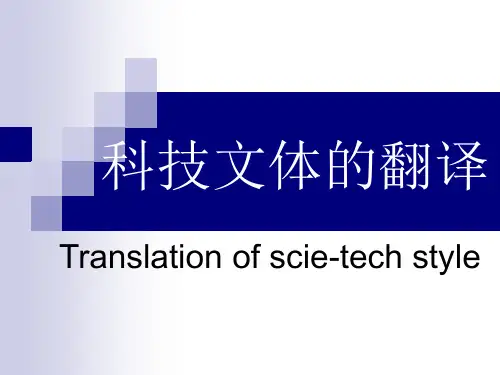
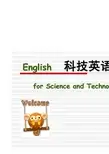
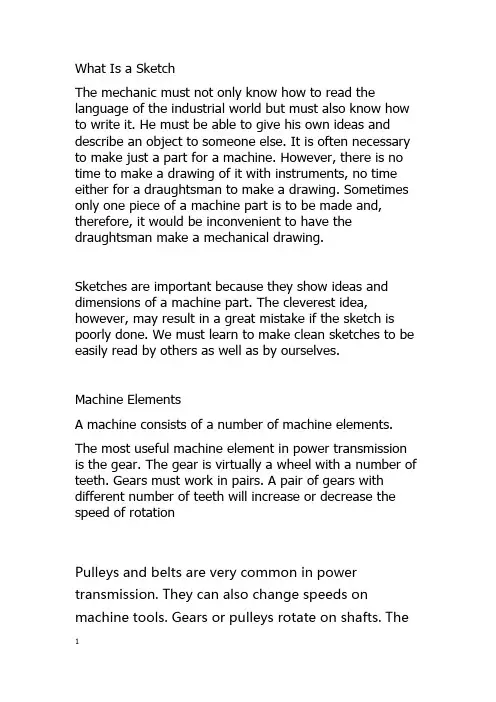
What Is a SketchThe mechanic must not only know how to read the language of the industrial world but must also know how to write it. He must be able to give his own ideas and describe an object to someone else. It is often necessary to make just a part for a machine. However, there is no time to make a drawing of it with instruments, no time either for a draughtsman to make a drawing. Sometimes only one piece of a machine part is to be made and, therefore, it would be inconvenient to have the draughtsman make a mechanical drawing.Sketches are important because they show ideas and dimensions of a machine part. The cleverest idea, however, may result in a great mistake if the sketch is poorly done. We must learn to make clean sketches to be easily read by others as well as by ourselves.Machine ElementsA machine consists of a number of machine elements. The most useful machine element in power transmission is the gear. The gear is virtually a wheel with a number of teeth. Gears must work in pairs. A pair of gears with different number of teeth will increase or decrease the speed of rotationPulleys and belts are very common in power transmission. They can also change speeds on machine tools. Gears or pulleys rotate on shafts. Theshaft must rest in bearings. Sometimes there may be couplings between shafts. We may use clutches to start or stop shaft motion.Some machine elements may be very large. Others may be very small. However, each of them plays a part in the construction of a machine.Cutting ToolsThe metal cutting tool separates chips from the workpiece in order to cut the part to the desired shape and size. There is a great variety of metal cutting tools. Each of them is designed to perform a particular job or a group of metal cutting operations in an efficient manner. For example, a twist drill is designed to drill a hole which has a particular size, while a turning tool may be used to turn a variety of cylindrical shapes.There are three basic types of metal cutting tools: single-point tools, multiple-point tools, and abrasives. A single-point metal cutting tool has a single cutting edge and is used for turning, boring, shaping, and planning. The most common machine tool that employs the single-point cutting tool is the engine lathe. Multiple-point tools have two or more cutting edges such as drills, reamers, and milling cutters. The cutting edge is that part of the tool where cutting is actually done. Grinding wheels are an example of abrasive cutting tools. Each grinding wheel hasa lot of abrasive grains which act as very small cutting tools.Limits and TolerancesMachine parts are manufactured so they areinterchangeable. In other words, each part of a machineor mechanism is made to a certain size and shape so itwill fit into any other machine or mechanism of the same type. To make the part interchangeable, each individual part must be made to a size that will fit the mating part inthe correct way. It is not only impossible, but alsoimpractical to make many parts to an exact size. This isbecause machines are not perfect, and the tools becomeworn. A slight variation from the exact size is alwaysallowed. The amount of this variation depends on the kindof part being manufactured. For example, a part might bemade 6 inches long with a variation allowed of 0.003( three thousandths ) inches above and below this size.Therefore the part could be 5.997 to 6.003 inches and stillbe the correct size. These are known as the limits. Thedifference between upper and lower limits is called the tolerance.When the tolerance is in both directions from the basic size, it is known as a bilateral tolerance ( plus and minus ). Sometimes the limit is allowed in only one direction. This is known as unilateral tolerance. For example, a hole may have to be 2 inches minus 0.000 inches, or plus 0.005 inches. This means that the hole must not be smaller than 2 inches, but can be as large as 2.005 inches.Surface FinishWithin recent years a great deal of attention has been given to the invesigation of the surface texture produced by various machining and finish operations, and, although we have not yet reached the stage when surface finish requirements can be specified and produced just as it is possible for a given dimension, information is being built up which may in the end bring this about.If a machine surface is reproduced to a large enough magnification it will be found to have a wevy profile, the character and shape of the waves varying for different machining methods. Equipment is now available which will produce an enlarged contour of a surface by traversing a needle-like probe over it, the instrument at the same time plotting on a chart a greatly magnified reproduction of the up-and-down movement of the probe with its longitudinal traverse.。
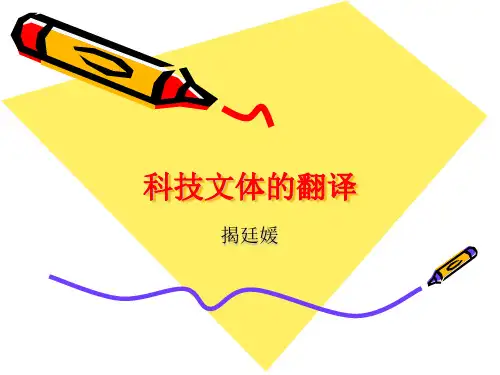
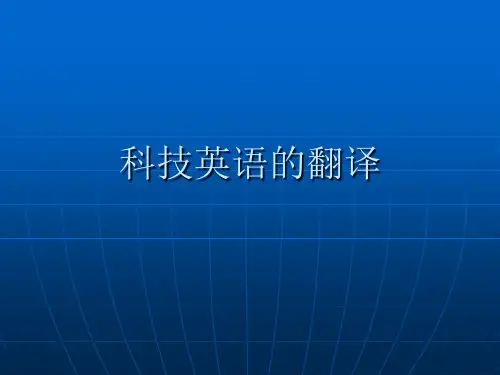


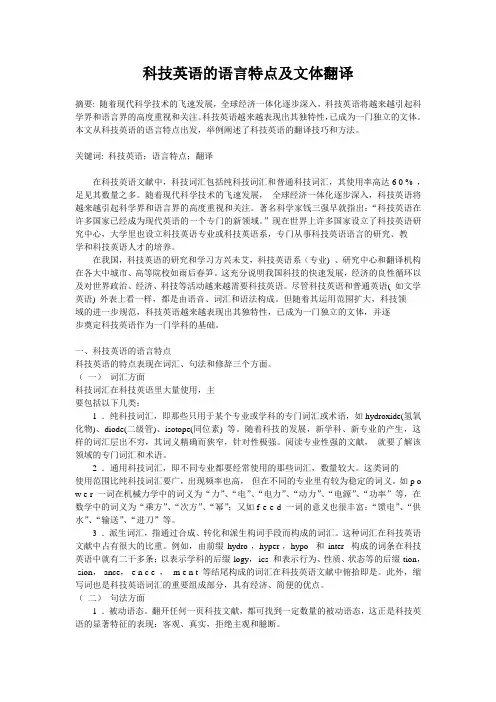
科技英语的语言特点及文体翻译摘要: 随着现代科学技术的飞速发展,全球经济一体化逐步深入,科技英语将越来越引起科学界和语言界的高度重视和关注。
科技英语越来越表现出其独特性,已成为一门独立的文体。
本文从科技英语的语言特点出发,举例阐述了科技英语的翻译技巧和方法。
关键词: 科技英语;语言特点;翻译在科技英语文献中,科技词汇包括纯科技词汇和普通科技词汇,其使用率高达6 0 % ,足见其数量之多。
随着现代科学技术的飞速发展,全球经济一体化逐步深入,科技英语将越来越引起科学界和语言界的高度重视和关注。
著名科学家钱三强早就指出:“科技英语在许多国家已经成为现代英语的一个专门的新领域。
”现在世界上许多国家设立了科技英语研究中心,大学里也设立科技英语专业或科技英语系,专门从事科技英语语言的研究、教学和科技英语人才的培养。
在我国,科技英语的研究和学习方兴未艾,科技英语系(专业) 、研究中心和翻译机构在各大中城市、高等院校如雨后春笋。
这充分说明我国科技的快速发展,经济的良性循环以及对世界政治、经济、科技等活动越来越需要科技英语。
尽管科技英语和普通英语( 如文学英语) 外表上看一样,都是由语音、词汇和语法构成。
但随着其运用范围扩大,科技领域的进一步规范,科技英语越来越表现出其独特性,已成为一门独立的文体,并逐步奠定科技英语作为一门学科的基础。
一、科技英语的语言特点科技英语的特点表现在词汇、句法和修辞三个方面。
(一)词汇方面科技词汇在科技英语里大量使用,主要包括以下几类:1 .纯科技词汇,即那些只用于某个专业或学科的专门词汇或术语,如hydroxide(氢氧化物)、diode(二级管)、isotope(同位素) 等。
随着科技的发展,新学科、新专业的产生,这样的词汇层出不穷,其词义精确而狭窄,针对性极强。
阅读专业性强的文献,就要了解该领域的专门词汇和术语。
2 .通用科技词汇,即不同专业都要经常使用的那些词汇,数量较大。
这类词的使用范围比纯科技词汇要广,出现频率也高,但在不同的专业里有较为稳定的词义。
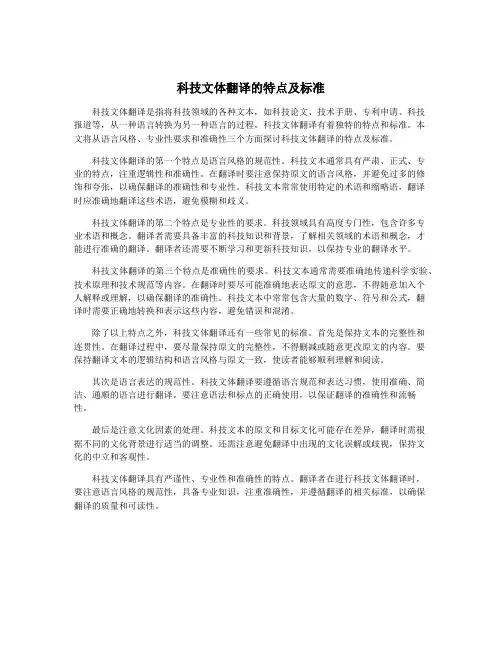
科技文体翻译的特点及标准科技文体翻译是指将科技领域的各种文本,如科技论文、技术手册、专利申请、科技报道等,从一种语言转换为另一种语言的过程。
科技文体翻译有着独特的特点和标准。
本文将从语言风格、专业性要求和准确性三个方面探讨科技文体翻译的特点及标准。
科技文体翻译的第一个特点是语言风格的规范性。
科技文本通常具有严肃、正式、专业的特点,注重逻辑性和准确性。
在翻译时要注意保持原文的语言风格,并避免过多的修饰和夸张,以确保翻译的准确性和专业性。
科技文本常常使用特定的术语和缩略语,翻译时应准确地翻译这些术语,避免模糊和歧义。
科技文体翻译的第二个特点是专业性的要求。
科技领域具有高度专门性,包含许多专业术语和概念。
翻译者需要具备丰富的科技知识和背景,了解相关领域的术语和概念,才能进行准确的翻译。
翻译者还需要不断学习和更新科技知识,以保持专业的翻译水平。
科技文体翻译的第三个特点是准确性的要求。
科技文本通常需要准确地传递科学实验、技术原理和技术规范等内容。
在翻译时要尽可能准确地表达原文的意思,不得随意加入个人解释或理解,以确保翻译的准确性。
科技文本中常常包含大量的数字、符号和公式,翻译时需要正确地转换和表示这些内容,避免错误和混淆。
除了以上特点之外,科技文体翻译还有一些常见的标准。
首先是保持文本的完整性和连贯性。
在翻译过程中,要尽量保持原文的完整性,不得删减或随意更改原文的内容。
要保持翻译文本的逻辑结构和语言风格与原文一致,使读者能够顺利理解和阅读。
其次是语言表达的规范性。
科技文体翻译要遵循语言规范和表达习惯,使用准确、简洁、通顺的语言进行翻译。
要注意语法和标点的正确使用,以保证翻译的准确性和流畅性。
最后是注意文化因素的处理。
科技文本的原文和目标文化可能存在差异,翻译时需根据不同的文化背景进行适当的调整。
还需注意避免翻译中出现的文化误解或歧视,保持文化的中立和客观性。
科技文体翻译具有严谨性、专业性和准确性的特点。
翻译者在进行科技文体翻译时,要注意语言风格的规范性,具备专业知识,注重准确性,并遵循翻译的相关标准,以确保翻译的质量和可读性。
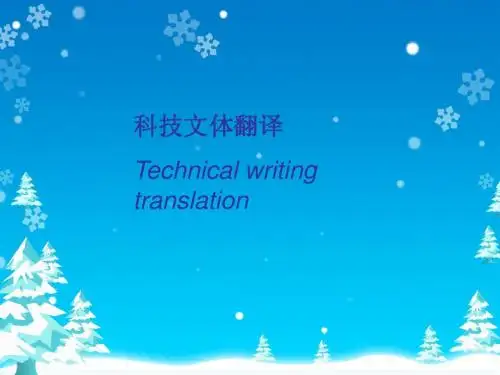
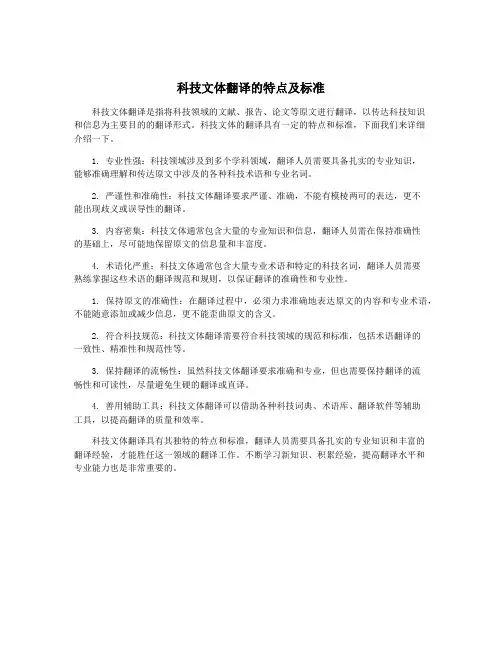
科技文体翻译的特点及标准
科技文体翻译是指将科技领域的文献、报告、论文等原文进行翻译,以传达科技知识
和信息为主要目的的翻译形式。
科技文体的翻译具有一定的特点和标准,下面我们来详细
介绍一下。
1. 专业性强:科技领域涉及到多个学科领域,翻译人员需要具备扎实的专业知识,
能够准确理解和传达原文中涉及的各种科技术语和专业名词。
2. 严谨性和准确性:科技文体翻译要求严谨、准确,不能有模棱两可的表达,更不
能出现歧义或误导性的翻译。
3. 内容密集:科技文体通常包含大量的专业知识和信息,翻译人员需在保持准确性
的基础上,尽可能地保留原文的信息量和丰富度。
4. 术语化严重:科技文体通常包含大量专业术语和特定的科技名词,翻译人员需要
熟练掌握这些术语的翻译规范和规则,以保证翻译的准确性和专业性。
1. 保持原文的准确性:在翻译过程中,必须力求准确地表达原文的内容和专业术语,不能随意添加或减少信息,更不能歪曲原文的含义。
2. 符合科技规范:科技文体翻译需要符合科技领域的规范和标准,包括术语翻译的
一致性、精准性和规范性等。
3. 保持翻译的流畅性:虽然科技文体翻译要求准确和专业,但也需要保持翻译的流
畅性和可读性,尽量避免生硬的翻译或直译。
4. 善用辅助工具:科技文体翻译可以借助各种科技词典、术语库、翻译软件等辅助
工具,以提高翻译的质量和效率。
科技文体翻译具有其独特的特点和标准,翻译人员需要具备扎实的专业知识和丰富的
翻译经验,才能胜任这一领域的翻译工作。
不断学习新知识、积累经验,提高翻译水平和
专业能力也是非常重要的。
科技文体翻译的特点及标准
科技文体翻译是指对与科技相关的文本进行翻译,包括科技论文、技术说明书、产品手册等。
科技文体翻译的特点和标准如下。
一、特点:
1.专业性强:科技文体的文本通常涉及到专业术语、技术规范等内容,需要翻译者有一定的专业知识和技能。
2.精准度高:科技文体翻译要求原文和译文在技术术语、规范、数据、单位、符号等方面保持精确一致。
3.规范性要求高:科技文体的文本通常有明确的规范和标准,翻译需要符合目标语言的规范和习惯。
4.语言简明清晰:科技文体的文本需要使用简明、清晰、准确的语言,让读者更容易理解和吸收。
二、标准:
1.专业知识和技能:翻译者需要具备与原文相关的专业知识和技能,例如科技领域的知识和研究经验,以及翻译技能和实践经验。
2.术语译法标准:翻译者需要掌握专业术语的译法,以及常见的主流术语翻译标准和习惯。
4.格式规范:翻译需要遵循目标语言的格式规范,例如字体、字号、行距、段落、标点等。
总之,科技文体翻译是一项重要的翻译工作,需要翻译者具备相关的能力和素质,以确保翻译的精度和准确性。
第六单元文体翻译第三节科技英语科技英语尤指自然科学方面:科技著述、论文、报告、方案等;科技情报与文字资料;科技实用手段的结构描述与操作说明;有关科技问题的会谈、会议、交谈用语科技影片、录像、视频等的解说词;科技发明、发现的报道;科学幻想小说,等等。
一、科技英语的特点例At first people believed that air was of only one gas. But by experiment they found out that it is made of two important gases and very small amounts of others.Here is a description of one experiment which they did to find out what one of these two important gases is.At first it was believed that air consisted of a single gas. But by experiment it was discovered that it consists of two important gases and traces of others.One experiment which was carried out to discover what one of these two gases might be, is described as follows:例If you fill a glass with water and drop into it a few crystals of permanganate of potash—written like this in chemistry: KMnO4, you see that the water near the crystals turns pink. If you heat the water, you can see the way in which the pink water moves. First it rises, then it moves across the surface, and then it sinks down the side of the vessel.If a glass vessel is filled with water and a few crystals of potassium permanganate—chemical formula: KMnO4 are dropped into it, the water near the crystals is seen to turn pink. If the water is heated, the way in which the pink water moves can be seen….(一)词汇特点1、词的性质:纯技术词:专业词汇或术语例:hydroxide,anode,isotope通用技术词:不同专业都使用的通用词汇,但在不同专业中,意义可能不同。
第一章知识要点:1.翻译:是一种语言转换活动2.刘宓庆在《现代翻译理论》中将“语际意义”概括为六种:概念(主题)意义、语境意义、形式意义、形象意义、文化意义。
3.美国翻译理论学家奈达将翻译的意义概括成:语义和问题。
“translating consists inreproducing in the receptor language the closest natural equivalent of the source-language message, first in terms of meaning and secondly in terms of style.”4.翻译的定义:翻译是把一种语言表达的意义用另一种语言传达出来,以达到沟通思想情感、传播文化知识、促进社会文明,特别是推动译语文化兴旺昌盛的目的。
5.翻译的分类:1.首先:就涉及的语言而论,翻译大体上分为:一:语内翻译,是指同一语言的各个语言变体之间的翻译;二:语际翻译,指不同语言之间的翻译。
2.第二,就其活动方式而言,分为:口译和笔译。
口译就是“口头翻译”,基本方式分两种:连续传译,又称即席翻译,发言人讲完部分或全部内容之后,由口译人员进行翻译;二是同声传译,口译员利用专门设备,边听边译。
笔译就是笔头翻译。
3.第三, 就翻译材料的文体而言,可分为应用文体、科技文体、论述文体、新闻文体、艺术文体。
4.第四,就处理方式而言,翻译可以分为全译、节译、摘译、编译和译术。
6.英国翻译家、学者乔治·坎贝尔率先提出了翻译三原则:首先,准确地再现原作的意思;第二,在符合译作语言特征的前提下,尽可能地一直坐着的精神和风格;第三,也是最后,使译作至少具有原创作品的特性,显得流畅自然。
7.英国翻译家泰特勒:一,译作应该完全复写出原作的思想;二,译作的风格和手法应该和原作属于同一性质;三,译作应该具备原创作品的通常。
8.中国:释道安“案本”;严复“求信”;傅雷“神似”;钱钟书“化境”。
科技文体的汉译英科技文体的范畴•科技文体可以泛指一切论及或谈及科学和技术的书面语和口语,其中包括:1. 科技著述、科技论文和报告、实验报告和方案;2. 各类科技情报和文字资料;3. 科技实用手册(Operative Means,包括仪器、仪表、机械、工具等)的结构描述和操作规程;4. 有关科技问题的会谈、会议、交谈的用语;5. 有关科技的影片、录像等有声资料的解说词,等等。
1. 科技著述、科技论文和报告、实验报告和方案;2. 各类科技情报和文字资料;•这两项科技英语,在文体学上统称为科学散文。
(scientific prose)科技英语文体总貌•着重叙事逻辑上的联贯(Coherence)及表达上的明晰(Clarity)与畅达(Fluency);避免行文晦涩,作者避免表露个人感情,避免论证上的主观随意性。
因此,科技英语总是力求少用或不用描述性形容词以及具有抒情作用的副词、感叹词及疑问词。
•科技英语结构力求平易(Plainness)和精确(Preciseness),因此尽力避免使用旨在加强语言感染力和宣传效果的各种修辞格,忌用夸张、借喻、讥讽、反诘、双关及押韵等修辞手段,以免使读者产生行文浮华、内容虚饰之感。
科技文体的一般特征•(1) 无人称(Impersonal)•(2) 语气正式(Formal in Mode ofSpeech)•(3) 陈述客观、准确(Objective andAccurate in Statement)•(4) 语言规范(Standard in Language)•(5) 文体质朴(Unadorned in stylistics)•(6) 逻辑性强(Strict in Logic)•(7) 专业术语性强(Concentrated inTechnical Terms)(1)无人称•绝大多数科技文章很少使用有人称的句子。
这主要是由于科技文章所描述和所讨论的是科学发现或科技实事。
尽管科技活动系人类所为,但由于科技文章所报告的主要是这种科技的结果或自然规律,而不是报告这些结果或自然规律是由谁发现或完成的,因此,科技文章往往没有人称。
•无人称不是绝对的;总的来说,人称句在科技文章中的比例很小。
•The general layout of the illumination system and lenses of the microscope corresponds to the layout of the light microscope. The electron “gun” which produces the electrons is equivalent to the light source of the optical microscope. The electrons are accelerated by a high-voltage potential (usually 40,000 to 100 000 volts), and pass through a condenser lens system usually composed of two magnetic lenses. The system concentrates the beam on to the specimen, and the objective lens provides the primary magnification. The final images in the electron microscope must be projected on to a phosphor-coated screen so that it can be seen. For this reason, the lenses that are equivalent of the eyepiece in an optical microscope are called “projector” lenses.(From Thornley G C, Further Scientific English Practice)(2)语气正式A Talk about CorrosionDr. Brown: Good Morning, Mr. Smith. Can I take your coat? Awful weather, isn‟t it? Sit down. Cigarette?Mr. Smith: No, I don‟t smoke, thanks very much.Dr. Brown: Well, I‟ve been looking into your enquiry about the corrosion trouble you‟ve been getting in the control valve. I‟m sorry you‟ve had trouble --- quite unexpected --- but I think we have the answer. The most probable cause of corrosion at a metal-to-metal junction immersed in an ionized fluid is electrolytic.(From BBC, Scientifically Speaking )(3)陈述客观、准确•科技文章是反映客观事实的,文章中不能参杂作者个人的主观意识,不能带个人感情色彩,对客观事实的陈述必须客观、准确。
这既是科技文章的特征,也是对科技文章作者的基本要求。
(4)语言规范•科技文章的语言一般比较规范,主要表现为语法的规范性。
这与文学作品有很大不同。
•科技文章的语法之所以规范,是因为其描述的客观事物必须准确无误这一要求决定的。
(5)文体质朴•在修辞手段上,科技文章以交际修辞为主(Dominated in communicative rhetoric), 文风质朴、描述准确,不像文学文体那样富于美学修辞(Aesthetic rhetoric)手段和艺术色彩。
•主要表现在语言的统一性(Unity)和连贯性(Coherence)强,语句平衡匀密,简洁而不单调,语句长而不累赘、迂回。
消极修辞和积极修辞•根据现代修辞学的观点,修辞的目的在于提高语言的表达效果(Brooks & Warren 1979)•消极修辞(交际修辞):在总体上注重逻辑思维,其重点在于使语言表达简明、流畅、准确,有效地发挥语言的交际功能。
“意义明确、伦次通顺、词句平匀、安排稳密。
”(陈望道)•积极修辞(美学修辞):在把握逻辑思维的基础上,偏重于语言表达的生动、活泼、优雅、具感染力,从而取得语言的艺术性表达效果。
•Sir, we have done everything that could be done to avert to the storm which is now coming on. We have petitioned; we have remonstrated; we have supplicated; we have prostrated ourselves before the throne, and have implored its interposition to arrest the tyrannical hands of the ministry and Parliament. Our petitions have been slighted; our remonstrances have produced additional violence and insult; our supplications have been disregarded; and we have been spurned, with contempt, from the foot of throne,…There is no longer any room for hope.•There is no retreat but in submission and slavery! Our chains are forged. Their clanking may be heard on the plains of Boston! The war is inevitable and let it come! I repeat it, sir, let it come!Is life so dear, or peace so sweet, as to be purchased at the price of chains and slavery? Forbid it, Almighty God! I know not what course other may take, but for me, give me liberty or give me death!(6)逻辑性强•概念准确,判断合理、恰当,推理严密。
赵祖谟《小说创作隐性逻辑》•“无论文学家还是科学家,其思维都离不开感情、形象、理性,这一点当前已形成共识。
那么小说家和科学家思维方式的不同究竟在哪里?就在于情感、形象、理性诸因素在整个思维活动中所处的地位、所起的作用不同。
科学家是人,而人不可能无情。
但科学家之情推动他力求客观地、冷静地做出判断、推理,科学家以抽象的论证为指归。
科学研究的成果既有抽象的理论又有形象的营构,其内核是理性,他力避主观情感对客观事物的介入。
”•“小说家是人,是人就不能无…理‟。
但小说家的理在整个创作过程中始终同…情‟紧密结合,不能一时一刻忘记…情‟。
小说家以创造形象为指归。
而形象的内核是…情‟,因而小说家要强化感情的介入,讲究移情。
”《小说创作隐性逻辑》•赵先生这里所说的“理”即是逻辑,“情”即是修辞(美学修辞)。
由此可见,无论科技文章还是文学作品,都离不开逻辑和修辞(美学修辞),只是前者逻辑性突出,而后者富于修辞(美学修辞)和艺术色彩罢了。
(7)专业术语性强•众所周知,科技文章(科普文章除外)均有一个专业范围。
一般来说,其读者均是“本专业”的科技人员,至少说是文章是为“本专业”的读者而写的。
•专业术语是构成科技理论的语言基础,其余一具有严谨性和单一性。
•采用术语写作能使文章更加准确而简洁。
专业术语十分密集•It is possible to prove that as the number of tosses of coin is increased indefinitely, or “to infinity”, so the binomial distribution becomes identical with the normal distrib ution. For each kind of random event there is an underlying distribution. The normal or Gaussian distribution is very important because it arises very often in practice and also because it is very important in theory. Many distributions like binomial tend to become more and more like the normal as the number of events or the size of the sample increases. •Another well-known statistical distribution is the Poisson distribution. If we are dealing with the frequency of occurrence of events which occur at random in time and space, we should expect the Poisson distribution to play some part in the calculation.(From BBC, Scientifically Speaking)借用动物名称的专业术语•英语日常用语意义机械专业术语意义•coat 外衣镀层•cap 帽子轴承盖,罩壳•shoe 鞋子闸瓦,履带片•cup 杯子皮碗,轴套•bed 床底座,机床身•bench 长凳拉床,钳工台•house 房子箱体,罩•disk 唱片硬磨盘•desk 书桌控制屏•table 桌子放料盘•英语日常用语意义机械专业术语意义•eye 眼孔环•ear 耳吊钩•mouth 口开度•nose 鼻喷嘴•hand 手手柄,指针•finger 手指厚薄规•foot 脚支座•head 头冒口,刀架•neck 颈座•body 身体机身•hair 头发游丝•tooth 牙齿粗糙面注意事项•任何一种文体的语言特征都不是绝对的。